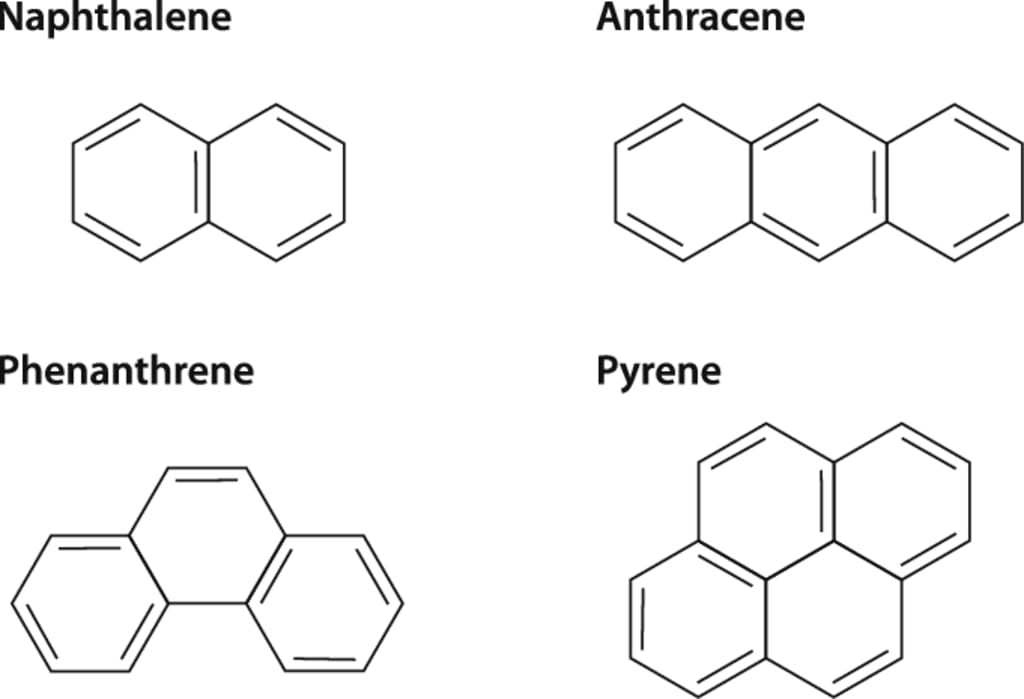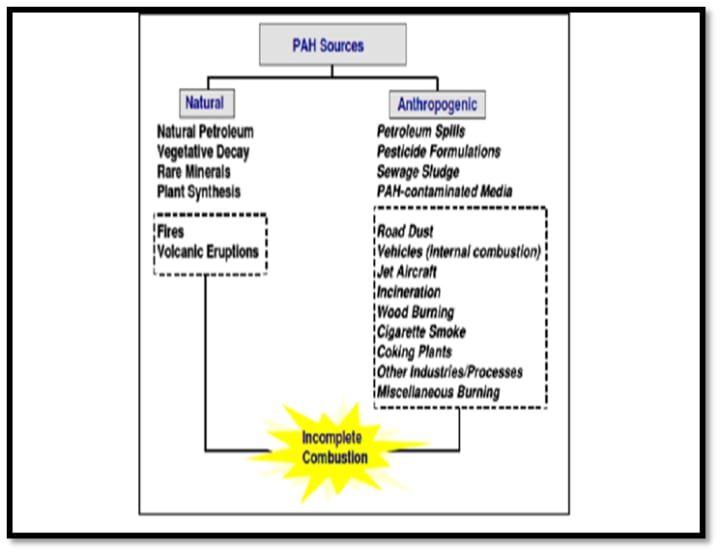Polycyclic aromatic hydrocarbons
Introduction, sources, classification and its characteristics.

Polycyclic Aromatic Hydrocarbons
Introduction:
Polycyclic aromatic hydrocarbons are chemical molecules with fused aromatic rings made primarily of hydrogen and carbon atoms that are both highly lipophilic and hydrophobic. These aromatic compounds are poisonous substances with a variety of structures that are semi- or non-volatile in nature, non-biodegradable, and persistent in the environment. These substances are released through industrial activities, cooking, burning of fossil fuels and wood, volcanic eruptions, and forest fires.
Classification of Polycyclic aromatic hydrocarbons
• Larger or Heavy polycyclic aromatic hydrocarbons.
• Smaller or Lighter polycyclic aromatic hydrocarbons.
Characteristics
They have high melting and boiling temperatures, little vapour pressure, and little solubility in water.
The latter two characteristics vary in an inverse relationship with molar mass.
Sources of Polycyclic aromatic hydrocarbons:
The three categories listed below, including pyrogenic, petrogenic, and biological, are the main sources of polycyclic aromatic hydrocarbons in the environment. Pyrogenic polycyclic aromatic hydrocarbons are produced anytime organic materials are subjected to high temperatures in the absence or presence of oxygen, a process known as pyrolysis.

From Biological process
The fact that PAHs can be created organically is not widely known. For instance, they may be produced during the breakdown of vegetative matter or by specific plants and microorganisms.
The physical and chemical characteristics of PAHs that affect their presence in food include:
The same physicochemical factors that govern polycyclic aromatic hydrocarbons' absorption and dispersion in humans also affect their presence in food. Their potential for transit and distribution between various environmental compartments, as well as their intake and accumulation by living organisms, are determined by their relative solubility in water and organic solvents. The volatility of PAHs affects how they move through the atmosphere. The environment's ability to degrade PAHs or their adsorption to organic matter is influenced by their chemical reactivity.
The presence of PAHs in various food categories:
A wide variety of food matrices, including dairy products, fruits and vegetables, cereal goods, meat and related products, confections, beverages, oils, medicinal plants and herbs, infant-based formulations, nuts and spices, are where PAHs develop and accumulate.
The process by which PAHs originate in food and the factors that control it:
The presence of PAHs in several food products has caused their cooking processes to come under scrutiny. The development of PAHs is said to be greatly influenced by processing, packing, and thermal activities like drying, smoking, baking, roasting, grilling, and frying, among others. High-temperature food combustion produces free radicals that recombine to create Light PAHs.
• Direct processes
• Miscellaneous processes.
Direct procedures that produce PAHs:
When a food is directly heated at high temperatures, PAHs are formed as a result of food combustion. Milk, a dairy product with a range of fat contents, is processed in a variety of ways, including pasteurisation and skimming. The evaluated PAHs in various heat-treated milk samples appeared in the increasing order of:
Raw milk< Pasteurized< Ultra High Temperature (UHT) semi-skimmed milk< UHT whole milk
Boiling:
Boiling has been suggested as the most likely cause of the PAH sinraw milk's presence. Even though the chemical has a decreased transfer rate in milk, it nonetheless effectively crosses the blood-mammary barrier and becomes a component of the milk. Additionally, the differences in the levels of PAHs in the UHT whole and semi-skimmed samples depended on the amount of fat in each sample and the interaction of its lipophilic components with milk triglycerides. In contrast, skimming milk decreased the PAH concentration in a different study.
It involves cooking beef, hake, potatoes, string beans, rice, and olive oil for varying amounts of time in 2-3 litres of boiling water to study the impact of cooking on the development of PAHs in various food products. In a different investigation, it was discovered that brewing coffee using filter rather than boiling resulted in greater levels of PAHs. It was found that the denouement profile and the addition of hot water had an impact on the leaching of these pollutants.
Drying
The elimination of moisture from food grains, oilseeds, vegetables, tea, etc. is frequently accomplished through drying. The future use of the dried corn heavily influences the type of fuel used, method of air heating, and composition of combustion gases employed throughout the process. Corn drying is carried out in industrial and other small-scale kilns. Two processes occur in conjunction with maize combustion: pyrolysis, which results in the generation of unstable PAHs, and pyrosynthesis, which favours transformation into more complex PAHs.
Conclusion:
The collection of substances known as polycyclic organic materials (POM) that includes PAHs. They are mostly pyrolyzed organic materials or incompletely burned organic molecules, which are how they are initially generated. These substances are linked to the usage of oil, gas, coal, and wood in the manufacture of energy. Indoor smoking and heating are two other factors that affect ambient air quality.
About the Creator
Enjoyed the story? Support the Creator.
Subscribe for free to receive all their stories in your feed. You could also pledge your support or give them a one-off tip, letting them know you appreciate their work.





Comments
There are no comments for this story
Be the first to respond and start the conversation.